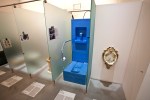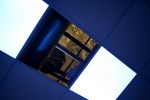In the context of the Venice Biennale’s long history, the International Architecture Exhibition is relatively new. Formally established in 1980, it opened its 14th edition this year. But despite its relative youth, the Architecture Biennale has generated much extended debate over the big questions at its core: what is an ‘architecture exhibition’, what could (or should) it be, and what ultimately is the critical point of such a Biennale?
introduction-9 Central Pavilion, ‘Elements of Architecture’, introduction. Courtesy la Biennale di Venezia. Photo: Francesco Galli

The first ever Architecture Biennale shook the architecture world with a powerful and provocative proclamation of Postmodernism as the new style. It offered a memorable exhibition of full-scale streetscapes and architectural installations to tell its story. In recent years however, the showcase has languished under weak (and too broad) curatorial narratives, housing a few too many ‘starchitect’ portfolio parades without real critical curatorship.
The usual hype and discussion surrounds the latest edition, but this time round the Biennale comes out strong from the debate, proving that insightful directorial guidance, a return to extended research and a renewed engagement with architecture’s fundamental elements can produce a coherent narrative and an engaging show – and also, rather importantly, some exciting new modes of exhibition.
Four highlights from the Venice Architecture Biennale
The current Biennale has been curated by critically acclaimed and provocative Dutch architect Rem Koolhaas, co-founder of the office OMA, and has seen the introduction of a new set of curatorial frameworks that bring a critical edge to an otherwise sprawling exhibition.
This year’s show is twice as long as previous Architecture Biennales, running for a period of six months, and Koolhaas spent twice the normal time researching and developing the show (nearly two years). He has also restructured the way in which the Biennale’s various parts – the National Pavilions, Central Pavilion and Arsenale – speak to each other and are curated. Rather than focusing his energies on curating the long halls of the Arsenale (as previous directors have done), Koolhaas chose to devote the area to a unified exhibit on a single theme, and turned his attention instead to the Central Pavilion in the Giardini and the panoply of National Pavilions, where participation was noticeably higher this year (65 compared to the previous 55).
All three zones are united under the banner of ‘Fundamentals’, which forms the central theme of this year’s Biennale – championing a revisiting of history in order to assess the present condition of architecture, and speculate on its future. Within this, the National Pavilions for the first time ever were given a set theme to engage with – ‘Absorbing Modernity 1914–2014’ – and worked more closely with the director on their content. The overall result is a series of research-rich exhibitions and a noticeably stronger presence of curators on the pavilion teams.
The Central Pavilion houses Koolhaas’s ‘Elements of Architecture’ exhibition, an extensively researched object-based survey of the history of architecture with a focus on its literal component parts (ceilings, floors, toilets…) realised in partnership with Harvard Graduate School of Design. The Arsenale’s Corderie hosts the ‘Monditalia’ exhibit, a reflection on Italy as a ‘fundamental’ country told through a collection of research projects and a geographically arranged study of the country’s 1914–2014 history; it forms a complementary but independent showcase. The Arsenale is also innovative this year for its active fusion with the Film, Music, Theatre, and Dance Biennales, the rehearsal and performance stages of which are interspersed amongst the ‘Monditalia’ exhibits.
Click here for four highlights from the national pavilions
The 14th International Architecture Exhibition runs from 7 June–23 November 2014.
Related Articles
Exhibiting Architecture: Highlights from Venice (Zofia Trafas)
The London Festival of Architecture
Art, Architecture and Sustainability at the Architecture Foundation (Camilla Apcar)







